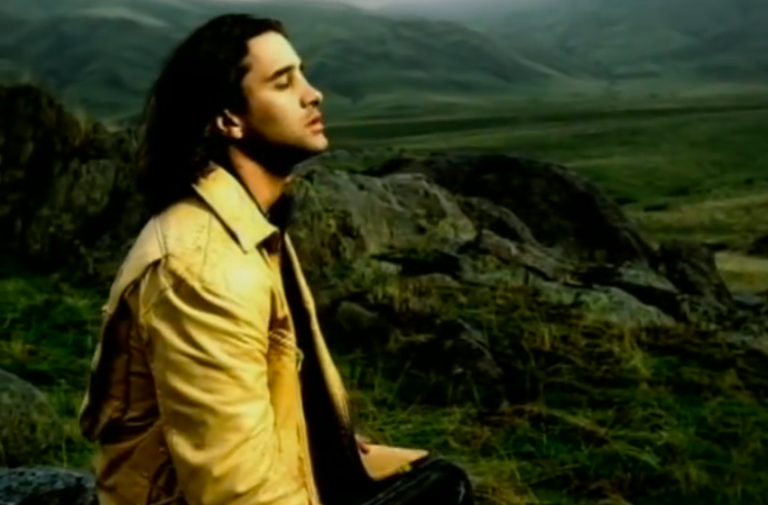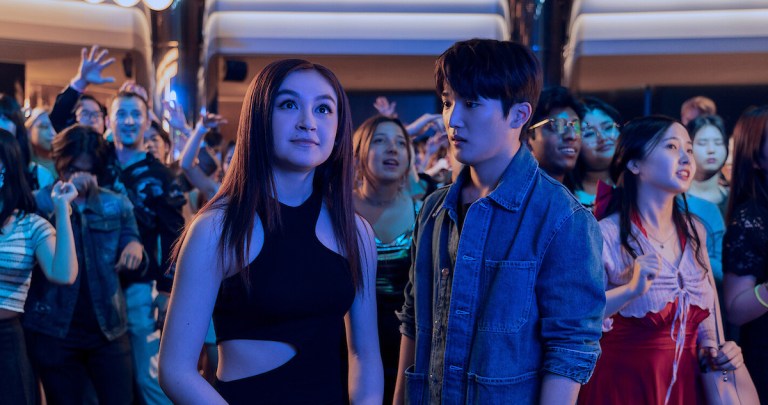This Mortal Coil: A Final Report on Peter “Sleazy” Christopherson
Peter "Sleazy" Christopherson, who in the '80s pioneered the industrial aesthetic with the band Throbbing Gristle, died in his sleep at his home in Bangkok on November 24. He was 55.
By Mark Dery


I REMEMBER THE ’80s. I remember reading about the New Romantics in Rolling Stone, sniggering at the silliness of the French-poodle quiffs and the geometric maquillage that turned nightclubbers’ faces into Russian Constructivist paintings but thrilling, nonetheless, to the return, after what felt like 40 years’ exile in the wastelands of punk’s squatter style, of glam. (With Bowie’s benediction, no less. For his “Ashes to Ashes” video, he lifted Steve Strange’s Pierrot costume and recruited the Blitz Kids as extras.) I remember leafing, with a sort of rapt contempt, through Face cover stories that split the difference between breathlessness and bored hauteur, assuring us on the other side of the red-velvet VIP rope that Haysi Fantayzee or Blue Rondo à la Turk or Blancmange or Bronski Beat or Rip Rig + Panic or [fill in the blank] was—yawn—the Next Big Thing. I remember a Face feature that took readers on a guided tour of August “Kid Creole” Darnell’s wardrobe, fondling his vintage suits, oggling his hand-painted 1940s’ neckties. I remember wearing a silver sharkskin suit, blindingly white Capezios (I retouched any smudges with White-Out), and a pink leopardskin tie from Fiorucci’s to Depeche Mode’s first gig in L.A., doing that electro-pop dance move everyone was doing then, cheeks sucked in like one of those mirrorshaded models in a Nagel poster, arms bent at the elbow, swiveling from the waist up, feet nailed to the floor, while the band played “Just Can’t Get Enough.” I remember moving to San Francisco in the summer of ’82, after graduating from college in Los Angeles, writing for little magazines with names like Poetry Flash and Art Com, walking home late one night after tending bar in a South-of-Market performance-art space (never an art “gallery,” always an art “space”), shuffling through snowdrifts of X-rated fortune-cookie slips disgorged by some loosely tied trashbags. I remember watching Deborah Iyall of Romeo Void, in a rented room so small you could barely wave your elbows, ironing her wedding dress. I remember how, before the Net—before the personal computer, in any real sense—magazines were the catacombs of cool, a subterranean network connecting kids who felt marooned in the tract-home desolation rows of suburbia with subcultural trends and weirdos like themselves. I remember the pre-Web sense of isolation from like minds, that Bruce Dern-in-Silent Running feeling of deep-space alienation that came from being the only kid in your high school who loathed jockdom and the bong-erati, the only one who’d rather sit in his room listening to Patti Smith’s Radio Ethiopia than go to the homecoming dance—a state of mind summed up by a poster for the L.A. punk band The Weirdos, a détourned comic-strip panel featuring a spiky haired, Raybanned guy saying, “Just think of it, Ellen—a world full of weirdos!” To which Ellen replies, “That would be wonderful…” I remember discovering Re/Search magazine’s “Industrial Culture” issue, with its grainy black-and-white photos of a band with the incomparable name of Throbbing Gristle, a band unlike any I’d ever read about in Creem or Circus or Rolling Stone, a band whose idea of a promo photo was recreating an archival image of the Manson family huddled in a cave at Spahn ranch, a band whose idea of a day off was taking William Burroughs target shooting, a band whose brain-stretchingly erudite, reference-studded interviews were a graduate seminar unto themselves, ricocheting with references to Situationism and sadomasochism, Surrealism and survivalism, the Viennese Aktionists and the Moors murderers, muzak and mind control, mail art and something called The Colour Atlas of Forensic Pathology, Nazi occultism and how to listen to Abba “against the grain,” with ears warped by irony. For industrial aesthetes, “access to information” was mission-critical, Jon Savage wrote, in his introduction. “The struggle for control” [in the Burroughsian sense of social control through mass media] “was now not territorial but communicatory.” Music, to TG, was just another media channel, “a vehicle for the transmission of information,” says Simon Reynolds in his book Rip It Up and Start Again: Postpunk 1978-1984, noting that if you took that philosophy literally, “there was a sense in which one might as well skip the records and just read the eloquent interviews…” Here was a world where the insurgent intellect was cool, where forbidden knowledge was coin of the realm—a world full of weirdos! The industrial aesthetic had come to kill hippie dead and beat on it—and not a minute too soon in a state that, in 1982, still reeked to heaven of patchouli and Spiritual Sky incense, and in a city awash in toxic runoff from the Summer of Love: Deadheads, New Agers, kooktopian commune-dwellers, love-bombed cultists, trust-fund votaries of saffron-robed shysters. “By ‘industrial,’ we mean the grim side of post-Industrial Revolution society—the repressed mythology, history, science, technology, and psychopathology,” wrote Re/Search editor V. Vale, in his preface to the Industrial Culture Handbook, making the grim side sound like a nice place to live, intellectually. Throbbing Gristle were the house band for postpunk’s cultural unconscious. Ballardian and Burroughsian to the core, they made the first truly post-industrial music; unmoored from any roots in the Afro-American blues tradition that anchored Rock as We Knew It, TG made sonic statements—sound as information—that, like Ballard’s Crash and Burroughs’s Nova Trilogy, responded to the media landscape and the built environment around them, anatomizing the posthuman psychology and social pathologies native to these environments. Mordant observers of “the savage realities of fading capitalism,” Throbbing Gristle were “writing about the future by looking at today,” says vocalist Genesis P-Orridge, in Rip It Up and Start Again. The band had “moved beyond the agrarian blues roots of rock and created a new kind of music (or antimusic) appropriate to postindustrial society,” writes Reynolds. I remember insinuating my starstruck twentysomething self into the inner circle of Re/Search magazine and being told at dinner by one of the editors, without a hint of irony, “The coolest people in America are right here at this table!” I remember moving in 1983 to New York, an island whose teeming millions of hipsters begged to differ with the Re/Search editor, and interviewing the poet John Giorno in the legendary windowless basement apartment where Burroughs had lived (“the Bunker”), drinking tumblers filled to the brim with vodka in a former YMCA shower room that Burroughs liked to say was haunted by the nude ghosts of wild boys, and waking up with a start, stupefied in my chair, in the small hours of the morning, the interview presumably over. I remember summiting a Kilimanjaro of cocaine with Nick Rhodes, the impossibly pretty keyboardist for Duran Duran, in a bathroom stall at Nell’s, a swank nightclub run by Little Nell of The Rocky Horror Picture Show. (I was nobody; I just happened to have a friend with a magically inexhaustible vial of coke.) I remember subjecting Rhodes to a lapel-grabbing, evangelical sermon on the genuis of Brian Eno, my astonishment growing by the minute as the keyboardist, taking the piss out of me with his best poker face, insisted that, no, he’d never heard of Eno. (I tell you these things not because they embroider my storied history, but to give you a thick description of the ’80s—to help you feel the texture of everyday life in that fulsome decade.) I remember finagling an interview with Peter “Sleazy” Christopherson, formerly of Throbbing Gristle, on the release of his band Coil’s album Horse Rotorvator—for the gearhead trade magazine Keyboard, ridiculously enough—because I simply had to interview a man named Sleazy whose record included songs with titles like “The Anal Staircase” and “Blood From the Air,” not to mention a goose-pimply, black-mass desecration of Leonard Cohen’s existentialist kaddish for suicides, “Who By Fire”:
And who by brave assent, who by accident,
who in solitude, who in this mirror,
who by his lady’s command, who by his own hand,
who in mortal chains, who in power,
and who shall I say is calling?
I remember interviewing him in the Broome Street Bar, in Soho. He was softspoken, diffident, with a coruscating intelligence and a sense of humor dry as bone dust. With his talk of sex magick and blood sacrifice, anal staircases and tape recordings of “this little kid laughing and saying things like, ‘My legs are starting to sweat,'” I found him genially, discreetly depraved. Which, then as now, impressed me no end.
Coil: The Darker Side Of Sampling
From Keyboard magazine, July 1987
Mark Dery
LONG BEFORE the verb was coined, Coil keyboardist Peter Christopherson started sampling.
As the tape player for Throbbing Gristle (a proto-industrial group whose music mixed boom-chuck machine rhythms, perky melodies, and mordant lyrics), Christopherson used a jury-rigged one-octave keyboard to trigger Sony stereo cassette decks. With it, he added shadows to such TG tunes as ‘Persuasion’ (Twenty Jazz Funk Greats), in which taped voices of kiddies at play underscore flatly intoned lyrics about a man who’s “got a little biscuit tin/to keep your panties in.”
“It was a box that [TG synthesist] Chris Carter made for me, to my design,” Christopherson recalls, “that basically switched on and off – through inputs on tape recorders – six cassette machines, the output of each going to a different key. Many of the machines I used in TG were cassette machines that were stripped down and altered to play backward and forward and four tracks at once, the speed variable by flywheels. The very first sampling device there ever was, as far as I know, was manufactured by Mountain Hardware for Apple computers. It was designed to reproduce voice samples, and had a very limited selection of pitches. I was using that onstage in ’79 or ’80, which was before the first Fairlight was used commercially. So I’ve always had a soft spot for sampling.”
That soft spot popped up in Christopherson’s work with Psychic TV, after Throbbing Gristle split up, and has become almost a raison d’etre in his current project, Coil, which formed around 1983. Strictly a studio band, Coil comprises himself and lyricist John Balance, who sings and plays Chapman Stick and some keyboards. They get an occasional hand from Steven E. Thrower, who mainly plays drums and brass.
Coil’s latest, Horse Rotorvator, hodgepodges Fairlight brass, sniff-clank percussion, Gregorian choirs, and lyrics about death, sex, and divine cannibalism. The real star, though, is Christopherson’s sampling. “In ‘Ostia’,” he informs, “there’s a recording of some grasshoppers that we made at Chichen Itza in Mexico. Chichen Itza is a pyramid that was used for the sacrifice of young men. Blood flowed down the steps of the pyramid and made it impossible to climb up.” The murmuring insects add atmosphere to the song, whose jumping-off point is the life and death of Pasolini, the Italian film director who was murdered by a “rent-boy” in Ostia, Italy.
The story behind the background scuffles and squeals on ‘The Anal Staircase’ is equally odd. “A tape was sent to us by a guy who’s sort of a fan of ours,” Christopherson says. “It’s the sound of him playing with his son. But because of the title of the song and the rather explicit nature of some of the lyrics, we thought it would be interesting to counterpoint the tape’s harmless sound with a lyric that had other overtones, to see if it would change the listener’s perception of this little kid laughing and saying things like, ‘My legs are starting to sweat.’ Immediately one begins to think that there’s something going on, some sort of torture scene.” As if that weren’t weirdness enough for one song, Christopherson adds with a chuckle, “the basic loop is a section of ‘The Rite Of Spring’ backward and upside-down, and at a quarter of the pitch. Somebody actually once told me that they recognized it.”
Making Stravinsky turn back-flips might sound a little theatrical, but that’s just the point. Coil strives for what Christopherson calls “a ‘big movie theater’ ambience”: a spacious, symphonic sound that echoes to the soundtracks of Arthurian romances, biblical epics, or old Steve Reeves movies. “We’ve always liked movies about Turkish prisons and Roman galleys,” Christopherson says. “Most contemporary music draws its imagery from the past 30 years, going back to the ’50s. But there’s a whole wealth of imagery from earlier times that’s fascinating to draw from.” Such Coil songs as ‘Slur’, ‘Ostia’, and ‘The Golden Section’ – with its clopping horses, voiced-over narration, and chanting galley slaves – are straight out of Cecil B. deMille.
Balance’s lyrics are also cinematic. Some songs were pieced together imagistically, like movie storyboards – such as ‘Blood From The Air’, a musical evocation, Christopherson says, of “something John read about a schizophrenic who lived in Alaska.” The song was “constructed by us just imagining a film in our heads about somebody walking through a very cold landscape and occasionally having mental attacks.”
Theatrics aside, Coil’s music has some decidedly down-to-earth aspects – namely, the hardware Christopherson uses. “Apart from the guitars and brass instruments and some live strings mixed with Fairlight III strings, everything else on Horse Rotorvator is artificial,” he notes. “Quite a lot of those sounds were created using an Emulator II function to destroy the original sample and produce something else. I used the VCAs and VCFs to do real-time modulation of the original sample.” The Emulator II also played a starring role in the songwriting. “The initial sequences consisted of multi-tracked sample combinations done on the Emulator,” he explains. “In most cases, what I did was download those sequences into a Fairlight by means of the MIDI output. You can edit much more easily on a Fairlight than on an Emulator.”
To avoid the android stiffness of sequence-based songwriting, Christopherson and company “try and con the machines into doing what we want, even though sometimes the machines weren’t designed to do that.” For Horse Rotorvator, the conned machines include a Fairlight II and III for sequencing and editing, Emulator II as the main sound generator, Yamaha DX7, PPG Wave 2.2, and an EMS Synthi for the heavy, distorted sounds. “The Synthi,” Christopherson says, “was like a portable version of their VCS-3, from ’72. It has a collection of VCAs and ring modulators. The way you connect the oscillators and filters is via a matrix board, where you put pins in to make the connections.” Additional artillery included “a few old Woolworth’s-type flangers and distortion pedals.”
But don’t be fooled by all the bits and bytes. Coil are not master musicians. “I can’t really play properly,” Christopherson asserts blithely. “None of us can really play in the conventional sense.”
For once, that old hokum about players “painting with sound” rings true. An artist whose bread and butter comes from directing TV commercials and pop videos (spots for the Firm and The The are among his recent credits), Christopherson composes Coil songs visually rather than musically. “As long as I can remember, I’ve approached music from a visual point of view,” he says. “Any technique that you can apply to a film, you can also apply to a piece of music. Our tunes that start off with a sort of film script or filmic picture are much more successful than the songs that start with a riff or bass line or conventional musical cue.”
Let other bands write songs; Coil makes ear movies. ![]()



